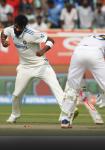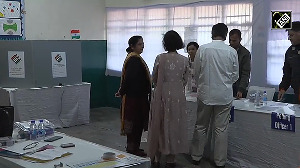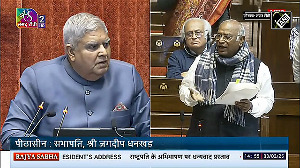They could, however, opt for tablet PCs that can put a majority of laptops to shame. Essentially, they are notebook-shaped (some even look like a slate) and you can write on them with the help of digitizing tablet technology or a touch screen. What that means is the stylus can do almost all the functions of a keyboard or mouse.
The tablet PC is much more flexible than a regular laptop. Holding a computer in tablet mode while reading an e-book or watching a movie is really convenient. Or maybe even watching pictures and videos with friends (putting the device into tablet mode) to get a closer peek at the screen.
Although tablet PCs made it to the shelves a while ago, they have never managed to shed their ivory tag for the masses. Not surprisingly, even today people are quite hesitant to include them in their IT budgets. Manufacturers, though, are singing a different tune. They claim there's a "mushrooming growth and demand for tablet PCs".
Most tablet PCs from leading vendors like the Sahara, Fujitsu, Thinkpad, Toshiba come equipped with digitizers that project a magnetic field above the screen which, in turn, interact with the tablet's stylus.
The user, therefore, is able to rest his hand on the screen without affecting the image or mouse pointer only the movement of the stylus affects the mouse pointer.
Sahara Computers and Fujitsu might not be very well known in Indian markets especially when it comes to tablet PCs but the players are fast gaining ground, with the introduction of high-end products that speaks volumes on their technical expertise.
The Fujitsu LifeBook P1510 and Sahara NB7630-N7 are convertible tablet PCs, which means their display can be swiveled and folded back making the system resemble a tablet.
Sahara's NB7630-N7 looks beefy and heavy, which it is 2.5 kg when compared with Fujitsu's Lifebook that weighs just about 1 kg.
How the tablets compare
Sahara's tablet packs in a 1.7 Ghz Intel Pentium M Dothan processor, 512 MB DDR, 12.1 inch TFT (gives a nice1024x768 resolution on its XGA screen), 80 GB hard disk is welcome and so is an 8x dual layer DVD burner.
It also encompasses standard features like LAN port, S-Video port, VGA port, 4 USB ports, a PCMCIA slot and wireless LAN as well.
Seemingly, Fujitsu's product primarily focuses on providing convertible tablets that are light enough to carry around like a pad of paper.
To some extent it has succeeded in making Lifebook compact and cute. An 8.9 inch wide display (gives a decent 1024 x 600 resolution on its SVGA screen) in a body sized 232 x 167 x 37 mm is compact without bunching up the keys.
In addition, the system has dual USB 2.0 ports, a fast ethernet port, a modem, an infrared port, a VGA port and dual type II PCMCIA slots.
Powered by Windows XP tablet PC Edition 2005 running atop an Intel Pentium M 753 processor at 1.2 GHz, the LifeBook P1510 is supported by 512 MB (supports up to 1 GB) and a hard drive of 60 GB, which is shock-mounted. In a nutshell, the Lifebook P1510 is hassle-free while running multiple applications.
The bad news, it does not have a built-in media access. Instead, it comes with a separate DVD/CD-RW drive that can be plugged into an USB port.
A thoughtful feature that other hardware makers should make note of is Fujitsu's annexing chamois-like leather patch (below the notebook chassis) that prevents scratching.
For wireless connectivity, tri-mode Wi-Fi 802.11a/b/g and Bluetooth serve well but infrared is nowhere to be found. The security features include an integrated fingerprint sensor and trusted platform module (missing in Sahara).
For the ease of the user, Sahara has added a scroll button that allows to scroll (a webpage or any other application) when the screen is folded over the keypad.
The viewing angle has to be exceptionally good in a tablet so that it terminates the probability of people tilting their heads in weird directions to be able to view whatever thay are browsing.
Both models score thumbs down on this aspect. During testing, Sahara lasted for almost 4.5 hours while Fujitsu went solid for up to four hours.
The Sahara NB7630-N7 retails for Rs 67,999 with a one year warranty and the Windows XP tablet PC Edition is bundled along with a mini-optical mouse.
Sahara has definitely pitched the NB7630-N7 at a price range that's less then its competitors and that too without compromising on quality and performance. A plus for them. But there is no way to turn the touch pad off and additionally it does not have Bluetooth.
The verdict
The most discriminating feature for any tablet PC is the digitizer quality. A tablet PC can change the way you compute more than any laptop could ever do, but you must invest some time to make that happen.
And it's worth it. User has to develop his skill in taking handwritten notes, creating drawings, annotating Microsoft PowerPoint presentations and above all using tablet PC input panel.
Both devices have a character (standard letter-by-letter), line (entire sentence input) and block (similar to Palm's preferred input method) recogniser built directly into the operating system, along with a virtual keyboard and the ability to write anywhere on the screen and have it translated into text.
This is by far the best feature of a tablet PC. The digitizer quality of the Sahara NB7630-N7 is slightly above average but Fujitsu scores higher. At Rs, 1,19,000 Fujitsu's Lifebook is worth every single penny when it comes to performance and mobility.
Want to discuss computer software? Join the Computer software Discussion Group







 © 2025
© 2025